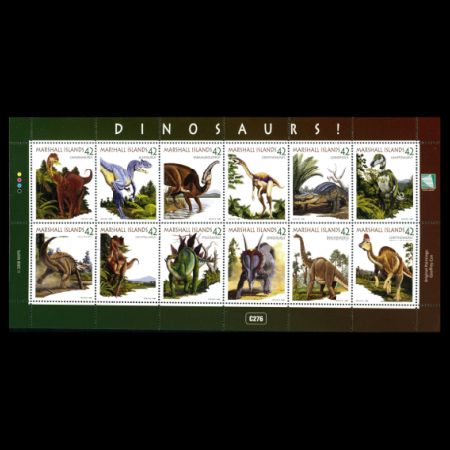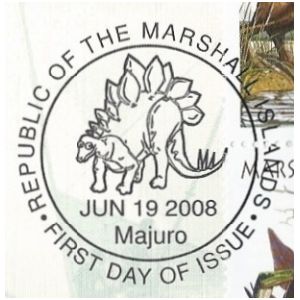Marshall Islands 2008 "Dinosaurs"
| <prev | back to index | next> |
| Issue Date | 19.06.2008 |
| ID | Michel: 2304-2315; Scott: 925 (925a-925l); Stanley Gibbons: 2197-2208; Yvert et Tellier: 2221-2232, 2197a ; Category: pR |
| Design |
Artwork: Geoffrey Cox, New Zealand
Engraver: D. Zoe Seemel FDC Design: Herb Kawainui Kane |
| Stamps in set | 12 |
| Value |
US$ 0.42 - Camarasaurus US$ 0.42 - Allosaurus US$ 0.42 - Parasaurolophus US$ 0.42 - Ornithomimus US$ 0.42 - Goniopholis US$ 0.42 - Camptosaurus US$ 0.42 - Edmontia (Edmontonia) US$ 0.42 - Ceratosaurus US$ 0.42 - Stegosaurus US$ 0.42 - Einiosaurus US$ 0.42 - Brachiosaurus US$ 0.42 - Corythosaurus |
| Emission/Type | commemorative |
| Issue place | Majuro |
| Size (width x height) | stamps: 34 x 43 mm, Mini-Sheet: 228mm x 114mm |
| Layout | Mini sheet of 12 stamps |
| Products | FDC x3 |
| Paper | unwatermarked gummed paper |
| Perforation | 13.5 x 13.4 |
| Print Technique | Cyan, black, magenta, yellow by offset lithography on unwatermarked gummed paper |
| Printed by | Printing, Cheyenne, Wyoming, U.S.A. |
| Quantity | |
| Issuing Authority | Marshall Islands Postal Service. |

On June 19th, 2008, the Marshall Islands Postal Service issued the Mini-Sheet with 12 stamps of Dinosaurs.
Below are, quotes from the official press release, of the Marshall Islands Postal Service, printed on the reverse side of FDC.
The name "dinosaur" comes from the Greek words dinos, meaning terrible, and sauros, meaning lizard. When these colossal reptiles ruled the earth countless millennia ago, North America was a low-lying continent with a great sea bordered by swamps. Huge plant-eating dinosaurs grazed in the steaming bogs and fearsome flesh-eating dinosaurs preyed upon the plant-eaters until, for unknown reasons, they all disappeared. One theory holds that when mountain ranges rose, the vast swampy home of the dinosaurs dried up and shifts in climate occurred, causing tremendous changes in the world's fauna. Old plants died out and were replaced by new ones which the plant-eating dinosaurs could not stomach. In turn, as the plant-eaters perished, the meat-eaters that fed upon them met their own demise, and the magnificent era of dinosaurs ended.
Featuring artwork by famed New Zealand artist Geoffrey Cox, the stamps show 12 of the most remarkable dinosaurs ever to walk the planet.
Notes: Goniopholis is not a dinosaur but a crocodilian, Edmontonia is misspelled Edmontia.
Products and associated philatelic items
| FDC | First-Day-of-Issue Postmark | |
 |
 |
|
References:
 |
- Technical details and short press releases:
Reverse side of FDC, Stampedout, colnect,
| <prev | back to index | next> |